
During the last couple years, we’ve been on the fence about the whole secularization of Christmas deal, but spending two holiday seasons in retail has proven that while people talk an admirable game when it comes to what they think Christmas is all about, it’s really just about consumerism in the end. And to that end, we’ve decided just to accept it, as one little website can’t even hope to make even the slightest ripple of change. But it’s okay. Sometimes going along for the ride has its benefits. Like being able to write articles about stuff one hopes to acquire during the season.
This particular list has a very specific focus: what Virtual Console games we’d like to see by the end of the year. Last year, Christmas fell on a Monday, and Nintendo offered a delicious bounty of AAA titles (Super Mario Bros, Super Castlevania IV, Street Fighter II, ToeJam & Earl, and R-Type) for the Virtual Console. The odds that they can top that lineup in one week are slim, so rather than say it’s a list of games we want to see on Christmas Eve, we’re saying it’s a list of what we want by 2008.
Now that our mission is stated, we’ll take a second to explain a couple generalities of our picks. First off, we’ve picked three NES games and two games each from the Super NES and N64. Genesis, TG16 and NeoGeo were omitted because frankly, we haven’t played many – if any at all – games for those consoles outside what’s already been offered on the Virtual Console service. Secondly, they may not all be super high quality, but they’ve all got a certain flair that makes them appealing to us, at least. Sometimes it’s a franchise bias, sometimes it’s a company bias, but mostly it’s rosy nostalgia glasses. Lastly, we’re only choosing from games released in North America to help keep the list down to seven titles. If we were to delve into imports, this list could go on forever and a day.
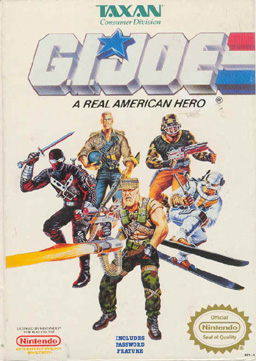
GI JOE
GI Joe is a game that we spent many, many hours on in our youth. In fact, it’s probably within our top ten NES games where time played is the deciding factor. We still quite enjoy booting this one up in an emulator now and then, just to see if we can finally get past that stupid desert level. It hasn’t happened yet.
In any case, we still really enjoy this game, even though the difficulty level is particularly brutal. It’s usually pretty fair though, and cheap deaths aren’t as common as in, say, the Legend of Kage. GI Joe is a particularly solid platform shooter, and is one of the earliest games we can recall where your character choice makes a difference. There were five Joes to choose from, Duke, Rock ‘n Roll, Blizzard, Captain Grid-Iron, and Snake-Eyes. Each mission starts by selecting a team of three, but really, it was just a matter of which other two Joes you’d be teaming up with Snake-Eyes. Who wouldn’t pick Snake-Eyes?
Levels were pretty straightforward, generally consisting of getting the Joes from point A to point B, and then facing a soul-crushingly difficult boss. On occasion, there are a couple levels where there are a set number of bombs to find and diffuse before exiting the area to face the boss. These were often far more difficult than the regular stages, because the stages were huge, and littered with secret paths, some that had to be found to get to a bomb. Some may call it cheap, but if we recall correctly, the hidden paths that led to bombs were usually more obvious than the ones that just hid power-ups.
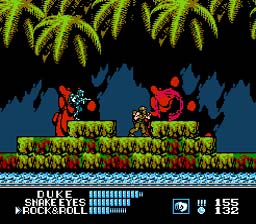
The last thing we feel we need to note is that the Joes can commandeer several Cobra vehicles. The Cobra Copter was found early in the game and obviously, provided the ability to fly and shoot the crap out of everything. The Cobra Buzz Boar was… a big buzzsaw. It rode along walls, and all we really remember it for is that one boss consisted of a battle against three of these mofos. It was a very common point of frustration. And then there was the cobra Pogo, which we frankly don’t remember using much. But it bounced real well and had a triple shot, so we suppose it was probably quite useful. Perhaps it’s just that we never got that far very often.
To say that GI Joe will definitely show up on the Virtual Console is a little premature. Whoever has the licensing rights to the new Sigma 6 cartoon obviously hates GI Joe (read: Sigma 6 is really bad), so it’s hard to say whether they’d let this quality NES game see the light of digital distribution. We can only hope, though, as we firmly believe that this game is still good, and it’s not just our fond memories for the title talking. We just hope Nintendo doesn’t shaft us with the comparably weaksauce Capcom title GI Joe: The Atlantis Factor.
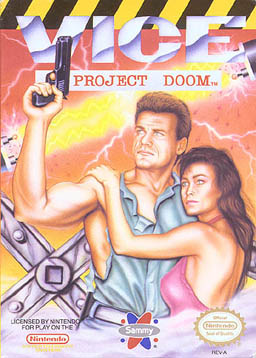
Vice: Project Doom
Another one of the few NES games we spent many an hour on back in the day. Vice: Project Doom is a game that as far as we can tell, went largely unnoticed by the general public. We received it as a random gift, back in the days when we didn’t know which games to ask for so our parents just bought whichever ones caught their eye. There were a couple stinkers, but Vice was a huge winner.
First off, Vice: Project Doom is your standard side-scroller, very similar to Ninja Gaiden. The major difference in the side-scrolling gameplay is that you’ve got three weapons to choose from at any time; a sword, a gun and grenades. Oh, and also there are driving levels that play like a souped-up Spy Hunter. The game actually starts with one of these. And before we forget, there are a couple of first-person shooting levels. We never enjoyed these levels much, but the rest of the game is totally solid. There’s even cutscenes and a complicated story, though it’s not told very well, and we stopped trying to make sense of it after level two.
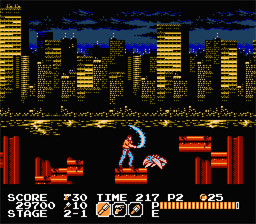
As opposed to GI Joe, it’s not an incredibly difficult game. There are some tough jumps (particularly in the jungle level), and the shooting levels are sometimes a little too full of enemies, but overall it’s very beatable. Which is sad because we’ve never actually gotten to the end. Made it to the last boss fight once recently, but couldn’t manage to win. We can’t quite remember if there are unlimited continues or not, but considering that fact that we usually made it pretty far into the game, and we remember dying a lot, there must have been. Games without unlimited continues are cruel.
So is there a chance of Vice showing up on the Virtual Console? We think sure, why not? In fact, Mark Bozon, an editor at IGN, also remembers and loves this game, and has been doing everything in his power to convince Sega and Nintendo to get it out there on the VC. We think that despite the fact that the last time we heard about the campaign (April), Nintendo wasn’t intending to bring it out, that it’s got a pretty good chance. It’s an excellent platformer, and highly competent Spy Hunter clone and shooter. There are certainly far more obscure titles on the service as we write this, so it’s not unlikely at all. As with pretty much any Virtual Console release, it’s just a matter of time.
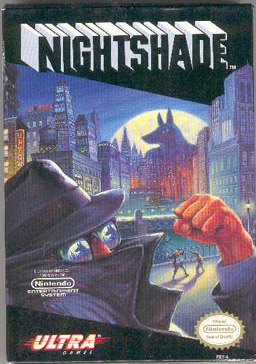
Nightshade
While the rest of the world was enjoying the secret of Monkey Island, its sequel, and all sorts of other wonderful PC adventure games, this is the closest we got to the genre until we were introduced to Space Quest IV a couple years later. Nightshade isn’t exactly the greatest of adventure games (the lack of a mouse in a point-and-click being the most obvious issue), it was enough to get us into the genre, and by the time we started playing PC adventures, we had a pretty good idea what was going on.
Nightshade is the best and only adventure game we’ve played on the NES. Though given how much we still enjoy it, we’re tempted to say that it would still be our favourite even if we had played any others. The story is light, being about a crime boss taking over Metro City and one guy going out to stop him, but unlike other games in the genre, the story is actually the least interesting part of the game. Basic adventure gameplay rules apply, essentially checking stuff, finding items, and using those items on other things. The adventuring part is much like Sam & Max in that it’s only really difficult because the items are often used in places you’d never expect. There are timed puzzles too, like at the beginning of the game, Nightshade tied up in a chair with a bomb ticking at his feet, and these help to liven up the pace of the game.
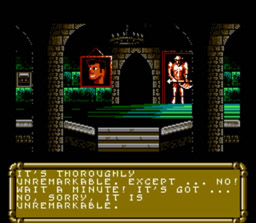
The only part of that game that really hits a sour note is that there is combat. Combat that isn’t executed overly well. We can’t think of anything in particular to liken it to, but we’ve never found that the fighting system worked too well. Or maybe the developers just made the enemies too hard, we’re not sure. In any case, it’s probably the only reason we’ve never made it to the end of the game. There are plenty of enemies, though the bulk of them are avoidable, with the exception of the bosses, of course.
As with most great adventure games, or at least, every one we’ve ever enjoyed, Nightshade is full of humour. The story takes kind of a back seat, but the writing is still actually really impressive for a NES game. Most of the citizens have multiple lines of dialogue, and a lot of those lines are one-liners. Being that there aren’t a ton of people to converse with, Nightshade also spews out plenty of wit when examining objects or using things. Why any games strive to be serious when comedy is so enjoyable is far beyond out grasp.
Seeing Nightshade on the Virtual Console seems like all but a pipe dream. It was never popular, but again, obscurity shouldn’t be too much of a factor. More likely to impede its induction is that fact that it isn’t really a niche title either. Vice: Project Doom actually has a small following, but we don’t think anyone outside one guy we hung out with as a kid and the dude who wrote up the Wikipedia page even knows this game exists. Licensing issues shouldn’t be too bad, as Beam Software does still exist as Krome Studios Melboure. However, it’s probably not going to happen. If games like Shadowgate and Déjà Vu start showing up on the VC, then our hopes will be lifted, but until then, all we can do is emulate illegally.
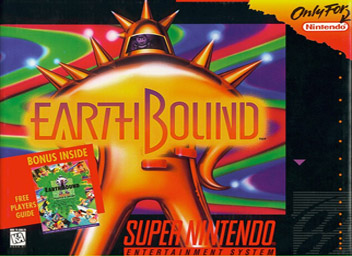
Earthbound
Be honest now, who didn’t see this one coming? Obviously Earthbound is one of the games with huge demand of Virtual Console representation. The only problem with it? Nintendo of America hates Earthbound fans. We won’t complain too much though, because Nintendo of Europe hates Earthbound fans even more.
The original game in the series, Mother was released on the NES many ages ago, translated for North American release, but then scrapped at the last moment. Earthbound was eventually released over here, but sold far less than expected, and never made it to Europe. The most recent game in the series, Mother 3 (on the Game Boy Advance), hasn’t even been considered for release outside of Japan. Nintendo of America has even flat-out said “Nope, we ain’t doin’ it. Fuck you guys.” That may be paraphrased, but the idea is the same.
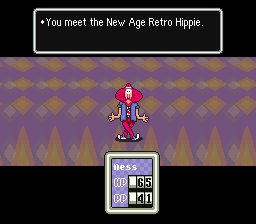
Anywho, there’s more to Earthbound than the fact that it’s the only game in a wonderful series we’ve ever gotten out of Nintendo. First off, it’s an RPG by Nintendo, which in itself is exceptionally rare. And while it may play exactly like Dragon Quest, it’s still got plenty of unique features to stand on. First off, it’s set in modern times instead of the usual bland medieval fantasy setting. This alone is refreshing enough, but it’s also got a thick coat of humour, and as we made clear when talking about Nightshade, we love humour. Everything about the game is charmingly oddball, and it’s just a shame we never got to see the rest of the Mother games.
From the blue-loving Happy Happy cultists to the fact that one of the main characters is named Poo, everything about Earthbound is wonderful. But as great as it is, it’s also a bit confusing at times. It’s one of those games where you actually have to pay attention to what people are saying. Yeah, one of those titles that was made before companies started highlighting the important words with different colours. To tat end, the game originally came packaged with the official Nintendo player’s guide. When we rented the game, Blockbuster courteously made sure to provide said guide as well, but that obviously won’t be so easy when it comes to the Virtual Console.
So what can Nintendo do? The Wii doesn’t currently have any multitasking abilities, so it’s not like they can put the guide on a separate channel. They could provide a digitized version instead of the half-assed manual they stick with every game, and since it’s accessible in-game, it’s totally possible. We don’t expect to see that level of devotion though. For any other game series, maybe, but to reiterate, Nintendo hates Earthbound fans. The game will be released on Virtual Console eventually though, that much is guaranteed. We just hope that NoA decides to put it on there before the year 2011.
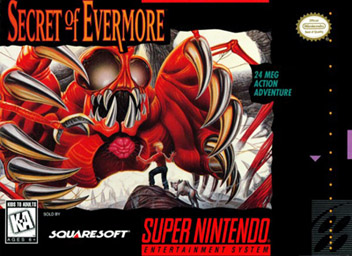
Secret of Evermore
Secret of Evermore is a huge anomaly in the world of video games. Probably for the best though. It’s a game by Squaresoft that was never released in Japan. Yeah. totally nuts. But that part aside, we really enjoyed the game. Apparently a spin-off of the Secret of Mana series, the game play essentially the same, with a similar combat system, and Mana’s ring menus. The big differences between Evermore and Mana are in the settings and the magic system.
Most RPGS, traditional, action or otherwise, are set in similar worlds. They’re always placed in a kind of generic fantasy setting. Earthbound was a nice departure from that mold, and Secret of Evermore also changes things up a bit. The story is based on time travel, and since the opening sequence is specifically set in the USA, the game obviously draws its inspiration for locations from human history. In all, there are four time periods; a caveman world, a Rome-/Egypt-based world, a medieval world, and a future world. Not really the most unique locales, but they certainly add a level of variety you don’t often get in this kind of game.
The magic system is even better, possibly because it’s not magic at all. Instead of some mystical force with which your character uses to light enemies on fire and whatnot, you’re granted the power of alchemy. So instead of leveling up and learning new spells, the main chracter learns new alchemy recipes from people and books. Instead of a given number of magic points to use, he has to forage the landscape (with the help of his dog) for materials to use for each recipe. Some materials can also be bought from shops scattered throughout the lands. It all sounds a bit more complex than necessary, but in reality, it works very well and provides a great number of abilities and choices to the main character, as opposed to a meager list of less than a dozen spells.
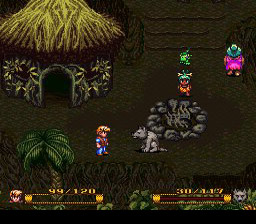
Being a Secret of Mana clone, as far as basic gameplay goes, Secret of Evermore works really well. This was of course, back in the day when the Mana series didn’t get a little worse with each installment. The basic combat systems are very similar if not the exact same, and the only real step back is that it’s only a single player game. We’ve spent a lot of good time playing Secret of Mana with others, and it’s just a shame that the fun can’t really be shared in Evermore. The plot only calls for one main character though, so it is an understandable loss. A second player could conceivably control the boy’s dog, but the two must be used separately at times, and having to wait for another player to finish a solo part of the game could really kill the multiplayer energy. And having to sniff out everything for the other player would be tedious as Hell.
Square-Enix hasn’t put forth a lot of support for the Virtual Console yet, but the fact that their first game on the service was Actraiser and not a Final Fantasy or Dragon Quest title really speaks to Evermore’s chances of being added. Actraiser was in the exact same boat: not extremely popular, but an undeniably solid game that has enough of a fanbase to make the company some money. We know Evermore doesn’t have the following of SE’s bigger franchises, but it’s still a high quality game and should not be overlooked.
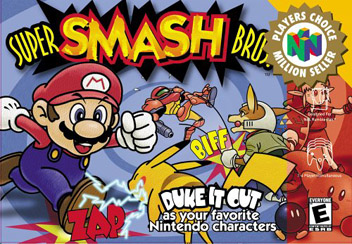
Super Smash Bros
Super Smash Bros Brawl is wihtout a doubt the most anticipated Wii game there has been since its announcement. It will probably be the best selling game on the Wii, much like Melee is for the GameCube. Nintendo went and broke our hearts when they pushed the release date back from December 4th to February 10th. To make up for this injustice (besides making sure Brawl is the best game it can be), Nintendo should give us the original Smash Bros to make up for it.
By this point, everyone must have an idea of what Super Smash Bros is all about. It’s probably not quite as far-reaching as Guitar Hero, but it has most certainly garnered a gigantic fanbase. Very few gamers will deny the majesty that is the Smash Bros series, and the ones who do simply hate fun. Also they murder puppies.
For the few who don’t know what Smash is, it’s a fighting game that stars a handful of Nintendo’s most popular mascot characters, from Mario to Pikachu to Fox McCloud. The difference between Smash and other fighters is that Smash is totally accessible to anyone. Players don’t need to learn complex button combinations or figure out the best way to chain attack together. Combos are mostly nonexistent and special moves can all be performed with a single button. It’s this simplicity that draws in the casual crowd, and the fact that it’s incredibly fun that brings in the core gamers.
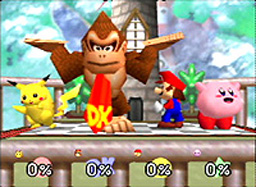
But with Melee in pretty much every home that has a Wii or GameCube and Brawl on the way, do people really want to play the bare-bones original? Why not? The game itself holds up very well, and being able to play it with a GC controller instead of the N64 monstrosity would brighten more than a few people’s days. Frankly, we’re looking forward to it because despite all the other additions, we vastly prefer the original stages to those in Melee. Don’t know why, but that’s just the way it is. Also, we feel that the first game’s version of the single-player “Classic Mode” is a little more satisfying than Melee’s.
Super Smash Bros is definitely going to show up on the Virtual Console soon. Ideally, we’ll see this on December 3rd to fill in for the delayed Super Smash Bros Brawl, but it’s more likely that Nintendo will hold onto it until the end of January to hype the release of Brawl. It’s coming either way, but here’s hoping that we get it sooner than later. If it were released now, we’d be playing it for two and a half months to come, but if they put it out right before Brawl, we’ll all forget about it come the new game’s release. But Nintendo doesn’t care, because either way, they’ll be making money hand over fist. We’re just saying it would make a nice Christmas gift is all.
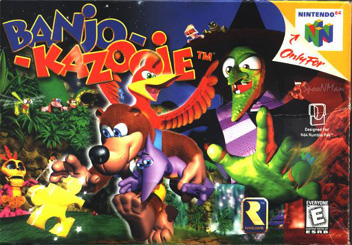
Banjo-Kazooie
The last game on our list is probably the most controversial. The bulk of the other games that people wouldn’t ask for are that way because they’re obscure and most wouldn’t even know what they are. Banjo-Kazooie, on the other hand, has a very polarizing effect on people. Half the gaming population love it, finding it to be a fantastic adventure with plenty to do, a hilarious cast of characters, and a wonderful soundtrack. The other half see it as a dreadful collect-a-thon. The fact of the matter, is that both sides are right.
Banjo-Kazooie is the first in a long line of Super Mario 64 imitators, only instead of challenging, gameplay related objectives, the majority of the game revolves around collecting various widgets. Or, at least, that’s what the nay-sayers would tell you. They’re right, there is a lot of collecting, but most of it does require a bit of skill, and let’s not forget that it encourages exploring. Searching every corner or a map just to search every corner of the map is all well and good, but having something there to find, be it a major item or just some ammo, certainly makes the trip more worth it.

The nice thing about Banjo-Kazooie is that it’s not as bad as people say. Banjo-Tooie and spiritual sequel Donkey Kong 64 were both far more mini-game oriented as far as challenges go, but Banjo-Kazooie’s rewards are more dedicated to the explorers and the platformers. It features a lot more actual gameplay without substituting mini-games where the developers couldn’t think up any more level-based challenges. This isn’t to say that there isn’t the odd mini-game, but they’re far more spread out, and feel less tedious as a result.
Being a Rare game, there’s also a good amount of humour in Banjo-Kazooie. for the most part, it’s rather blunt, with characters blatantly making fun of each other, but there are a few points where the game can produce a LOL or two. Another attribute that was very common in Rare games at the time was that some female characters were, well, vigorously endowed. It’s not really a point that will make anyone sway either way, but while it’s not overly apparent in BK, in later titles it just gets shameless. All of that pretty much culminates into Conker’s Bad Fur Day, which is another game we’d like to see on the VC, but that’s just not going to happen.
Banjo-Kazooie itself is very questionable as far as whether it will ever be a Virtual Console club member. The obvious roadblock is that Microsoft now owns Rare, and most companies won’t help to make games available for the competition’s systems. The only reason we even suggest it is because despite this little issue, Rare has been and is continuing to support Nintendo’s handheld scene. If Banjo-Kazooie were to show up on Virtual Console, Rare would just be raking in free money, as there’s obviously not much work going into these releases other than the lame manuals and making sure the emulation works right. At $10 a pop, any of those minor costs would be recouped within a day’s time.

